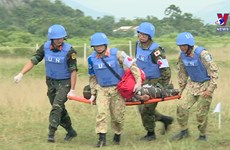Healthcare services in Mekong Delta improved
Healthcare services in the Mekong Delta have been improved in recent
years with a number of criteria surpassing the national average, said
the Steering Committee for the Southwestern Region.
Healthcare services in the Mekong Delta have been improved in recent
years with a number of criteria surpassing the national average, said
the Steering Committee for the Southwestern Region.
While 56.4 percent of the regional communes have met national standards on communal health care for the 2011-2020 period, the rate of malnourished children has dropped to 13.9 percent, compared to the country’s averages of 52.2 percent and 15.3 percent, respectively.
The committee attributed such an outcome to great funding for local medical infrastructure and personnel training which was sourced from the Government bonds, official development assistance, and various national and regional health care projects.
New clinics were built region-wide while others were upgraded and equipped with more modern facilities such as ultrasound scan machines, endoscopes, and biochemical analysers. At the same time, medical staff at provincial hospitals were reshuffled and sent to local clinics to help improve the quality of medical services.
However, the committee also acknowledged some problems in the Mekong Delta’s health care system, particularly the shortage of doctors. There were only 5.1 doctors and 0.46 pharmacists for every 10,000 people in the region, much lower than the national average of 7.5. The ratio of patient beds to 10,000 people reached only 17.7, compared to 23.8 on average in Vietnam.
Meanwhile, the use of unhygienic water in the region is still common, leading to the high risk of contracting digestive diseases, dengue, and pesticide contamination. The Mekong Delta is also short of private hospitals with cutting-edge equipment.
The steering committee said the region’s medical sector will actively take actions to prevent diseases, especially during and after the flood season, and better services for the poor, ethnic minority people and under-six children.-VNA
While 56.4 percent of the regional communes have met national standards on communal health care for the 2011-2020 period, the rate of malnourished children has dropped to 13.9 percent, compared to the country’s averages of 52.2 percent and 15.3 percent, respectively.
The committee attributed such an outcome to great funding for local medical infrastructure and personnel training which was sourced from the Government bonds, official development assistance, and various national and regional health care projects.
New clinics were built region-wide while others were upgraded and equipped with more modern facilities such as ultrasound scan machines, endoscopes, and biochemical analysers. At the same time, medical staff at provincial hospitals were reshuffled and sent to local clinics to help improve the quality of medical services.
However, the committee also acknowledged some problems in the Mekong Delta’s health care system, particularly the shortage of doctors. There were only 5.1 doctors and 0.46 pharmacists for every 10,000 people in the region, much lower than the national average of 7.5. The ratio of patient beds to 10,000 people reached only 17.7, compared to 23.8 on average in Vietnam.
Meanwhile, the use of unhygienic water in the region is still common, leading to the high risk of contracting digestive diseases, dengue, and pesticide contamination. The Mekong Delta is also short of private hospitals with cutting-edge equipment.
The steering committee said the region’s medical sector will actively take actions to prevent diseases, especially during and after the flood season, and better services for the poor, ethnic minority people and under-six children.-VNA













